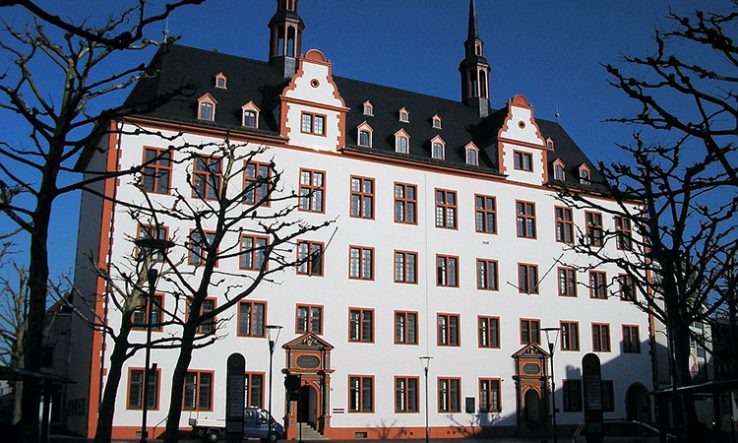
Image: de Benutzer Moguntiner [CC BY-SA 2.5], via Wikimedia Commons
The institute giving young scholars much-needed time away
Housed in a 17th century building that was rebuilt after its bombing in the Second World War, the Leibniz Institute of European History (IEG) in Mainz, Germany, offers doctoral and postdoctoral researchers the opportunity to live and work at the institute for short-term fellowships.
Historians from any country can apply and there is a small, permanent academic staff with whom fellows are encouraged to collaborate.
The next deadline for postdoctoral fellowships, which are awarded once a year, is on 15 October. The doctoral fellowships programme, meanwhile, has two deadlines per year, on 15 February and 15 August. The fellowships are jointly funded by the national and state governments in Germany, and doctoral fellows receive a monthly allowance of €1,350, while postdoctoral fellows receive €1,800.
Doctoral fellows usually come in their final year, to write up their project, whereas postdoctoral fellows arrive for “either a follow-up on the PhD thesis or a completely different one”, research coordinator Joachim Berger says. Postdoctoral applicants must have been awarded their doctorate no more than three years before the beginning of the fellowship. “They are in the process of reorienting their academic career, and we try to help them in this process.”
The IEG is one of 96 independent German research institutions outside of the university system that are a part of the Leibniz Association, covering a wide spectrum of disciplines. As the institute is fairly small, with limited space in the hall of residence, the IEG only has a few places available to scholars. Berger says that each year it awards between 16 and 32 doctoral fellowships and three to six postdoctoral fellowships, each of which can last for between six and 12 months.
Places on the fellowship programme are competitive with the success rates for doctoral fellows at around one in five, and for postdoctoral fellows around one in 10, according to Berger. He says that the overarching criterion for judging proposals is academic excellence.
“The proposal has to be well written, state of the art, and have an interesting angle or perspective on the research topic,” he adds.
While doctoral fellows will already have their topic fleshed out before applying to the IEG, postdoctoral fellows have more scope to choose what they work on, and the IEG funds research projects on European history from the early modern period until 1990.
In particular, the institute takes an interest in projects that take a comparative or cross-border approach, that relate European history to the wider world, or are focused on intellectual and religious history. Berger says that the IEG’s approach to European history is more than a sum of different national perspectives. Instead, it is a transnational approach—one that has become popular in the historical sciences, and which the IEG has taken for two decades or more.
“This international or transnational perspective is mirrored also in the profiles of most of our fellows,” Berger notes. “They have an international orientation during their studies in their specialisation, but also in their individual CV and background. They usually study at foreign universities and speak several languages.
“We try to combine as many national perspectives on European history as possible and we expect from our fellows that their individual projects reflect this cross-border perspective.”
Collaborative opportunities
The IEG has an ongoing research programme on ‘negotiating differences in Europe’, which has been running since 2012, and while Berger says that it isn’t a requirement for postdoctoral fellows to integrate their projects into this programme, it is an option.
He explains that there are three research groups of five to 10 younger scholars alongside members of the academic staff. Postdoctoral fellows who want to work with these groups are invited to do so.
In general, the IEG likes fellowship applicants to demonstrate their intention to collaborate with the institute’s academics. Berger highlights that there is a space for detailing potential collaborations in the application form, including thematic connections between the proposed project and ongoing research at IEG.
Collaboration covers a wide range of forms, from informal chats on a research topic, through to collaboratively writing a paper together, he adds.
There is also ongoing engagement with fellows after they leave the institute, and the potential for extending fellowships and collaborating further with the IEG, particularly in bidding for third-party funding.
“We try and encourage the project that they apply for being based at IEG, because that strengthens our research output in general,” Berger says, “but we also try to support them in the process of applying, either in a formal way or in a thematic way.
“We’ve had postdoctoral fellows contributing to, for example, edited volumes that some IEG researchers put together and they write a chapter based on their individual project.”
Berger’s advice for potential applicants is to focus on showing the European transnational potential of their topic, above all else, and to “write a proposal that you would like to read yourself”.
This is an extract from an article in Research Professional’s Funding Insight service. To subscribe contact sales@researchresearch.com